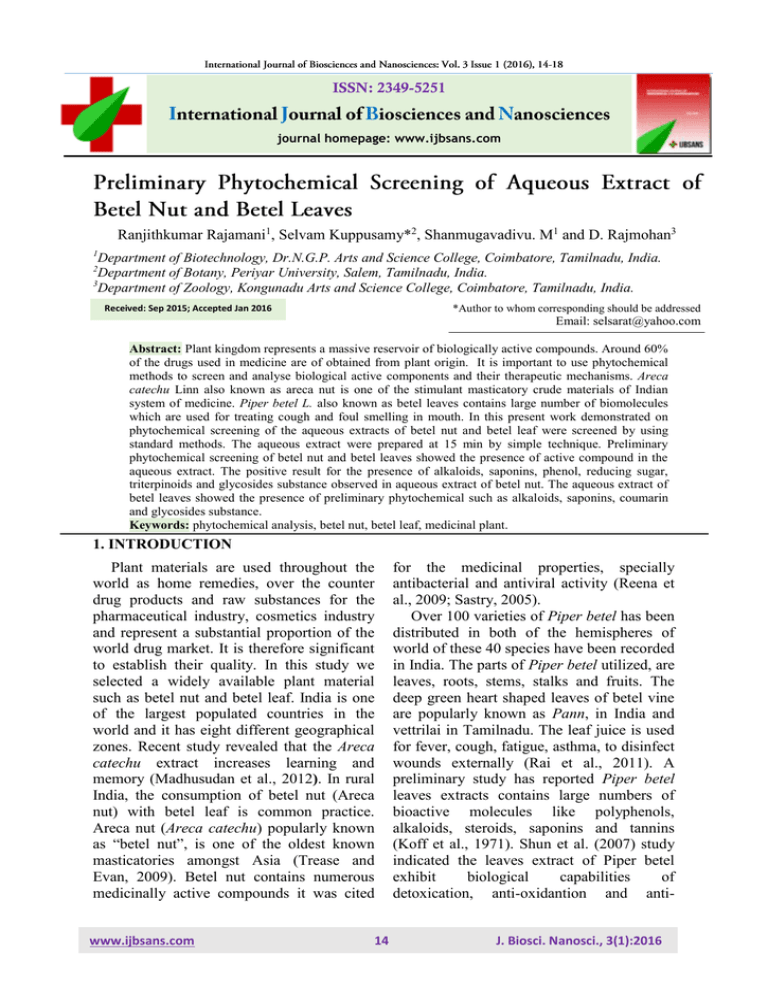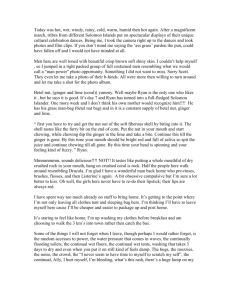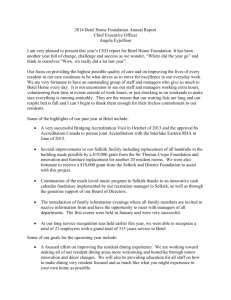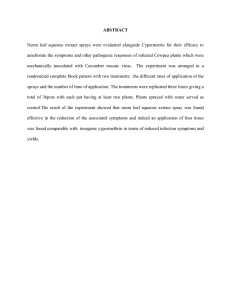1. INTRODUCTION Plant materials are used throughout the world as
advertisement

ISSN: 2349-5251 journal homepage: www.ijbsans.com Ranjithkumar Rajamani1, Selvam Kuppusamy*2, Shanmugavadivu. M1 and D. Rajmohan3 1 Department of Biotechnology, Dr.N.G.P. Arts and Science College, Coimbatore, Tamilnadu, India. Department of Botany, Periyar University, Salem, Tamilnadu, India. 3 Department of Zoology, Kongunadu Arts and Science College, Coimbatore, Tamilnadu, India. 2 Received: Sep 2015; Accepted Jan 2016 *Author to whom corresponding should be addressed Email: selsarat@yahoo.com Abstract: Plant kingdom represents a massive reservoir of biologically active compounds. Around 60% of the drugs used in medicine are of obtained from plant origin. It is important to use phytochemical methods to screen and analyse biological active components and their therapeutic mechanisms. Areca catechu Linn also known as areca nut is one of the stimulant masticatory crude materials of Indian system of medicine. Piper betel L. also known as betel leaves contains large number of biomolecules which are used for treating cough and foul smelling in mouth. In this present work demonstrated on phytochemical screening of the aqueous extracts of betel nut and betel leaf were screened by using standard methods. The aqueous extract were prepared at 15 min by simple technique. Preliminary phytochemical screening of betel nut and betel leaves showed the presence of active compound in the aqueous extract. The positive result for the presence of alkaloids, saponins, phenol, reducing sugar, triterpinoids and glycosides substance observed in aqueous extract of betel nut. The aqueous extract of betel leaves showed the presence of preliminary phytochemical such as alkaloids, saponins, coumarin and glycosides substance. Keywords: phytochemical analysis, betel nut, betel leaf, medicinal plant. 1. INTRODUCTION Plant materials are used throughout the world as home remedies, over the counter drug products and raw substances for the pharmaceutical industry, cosmetics industry and represent a substantial proportion of the world drug market. It is therefore significant to establish their quality. In this study we selected a widely available plant material such as betel nut and betel leaf. India is one of the largest populated countries in the world and it has eight different geographical zones. Recent study revealed that the Areca catechu extract increases learning and memory (Madhusudan et al., 2012). In rural India, the consumption of betel nut (Areca nut) with betel leaf is common practice. Areca nut (Areca catechu) popularly known as “betel nut”, is one of the oldest known masticatories amongst Asia (Trease and Evan, 2009). Betel nut contains numerous medicinally active compounds it was cited www.ijbsans.com 14 for the medicinal properties, specially antibacterial and antiviral activity (Reena et al., 2009; Sastry, 2005). Over 100 varieties of Piper betel has been distributed in both of the hemispheres of world of these 40 species have been recorded in India. The parts of Piper betel utilized, are leaves, roots, stems, stalks and fruits. The deep green heart shaped leaves of betel vine are popularly known as Pann, in India and vettrilai in Tamilnadu. The leaf juice is used for fever, cough, fatigue, asthma, to disinfect wounds externally (Rai et al., 2011). A preliminary study has reported Piper betel leaves extracts contains large numbers of bioactive molecules like polyphenols, alkaloids, steroids, saponins and tannins (Koff et al., 1971). Shun et al. (2007) study indicated the leaves extract of Piper betel exhibit biological capabilities of detoxication, anti-oxidantion and antiJ. Biosci. Nanosci., 3(1):2016 mutation that suggested the chemopreventive potential of extracts against various ailments including liver fibrosis and carcinoma. Research on identification of biologically active compound of plant origin as an alternative remedy to various health issues is well advanced. In the present work deals with preliminary phytochemicals analysis of betel nut and betel leaf aqueous extract by using standard methods. Triterpinoids, Phlobatannins, Acids and Glycosides. 2.3.1 Alkaloids (Raaman, 2006): Solvent free extract, 50 mg of the plant sample was stirred with one ml of dilute hydrochloric acid and filtered. The filtrate was tested for alkaloids. 2.3.2 Mayer’s Test: To the filtrate, a drop of Mayer’s reagent was added along the sides of the test tube. A white precipitate indicates the test as positive. 2.3.3 Flavonoids (Alkaline reagent test): Two ml of aqueous solution of the extract was treated with 1 ml of 10% ammonium hydroxide solution. Yellow fluorescence indicates the presence of flavonoids (Raaman, 2006). 2.3.4 Saponins: Fifty mg of the plant sample was ground with 3 ml of distilled water and diluted with the same, made-up to 20 ml. The suspension was shaken in a graduated cylinder. After 15 min, a two cm layer of foam indicates the presence of saponins (Raaman, 2006). 2.3.5 Phenols (Ferric chloride test): About 50 mg of the sample was dissolved in 5 ml of distilled water. To this few drops of neutral 5% ferric chloride solution was added. A dark green color indicates the presence of phenolic compounds (Raaman, 2006). 2.3.6 Glycosides (Keller-kilani test): Crude extract was mixed with 2ml of glacial acetic acid containing 1-2 drops of 2% solution of FeCl3. The mixture was then poured into another test tube containing 2ml of concentrated H2SO4. A brown ring at the interphase indicated the presence of cardiac glycosides. 2.3.7 Reducing Sugar: To 0.5 ml of the aqueous extract of the plant sample, 1 ml of water and 5-8 drops of Fehling’s solution was added at hot and observed for brick red precipitate ((Iyengar, 1995). 2.3.8 Tannins: One ml of water and 1-2 drops of ferric chloride solution was separated and 1 ml of aqueous extract of the plant sample. Blue color was observed for gallic tannins and green black for catecholic tannins (Iyengar, 1995). 2. MATERIALS AND METHODS 2.1 Preparations of the betel nut extract: Betel nut was collected from local market nearby our college, Coimbatore, Tamilnadu, India. The betel nuts was rinsed with distilled water thoroughly to remove dirt and other attached particles. The betel nuts extract was prepared by taking 20 g of thoroughly washed and finely cut betel nuts in a 250 ml Erlenmeyer flask with 100 ml of sterile distilled water and then boiled the mixture for 10 min. The solution was then removed from the head source and left at room temperature. Following this step the extract was then filtered through a Whatman filter paper No.1. The extract was kept in refrigerator at 4ºC for further experiments. 2.2 Preparations of the betel leaf extract: Apparently healthy betel leaves were collected from local market nearby our college and washed thoroughly in tap water to remove dirt and other attached particles. The betel leaves extract was prepared by taking 20 g of thoroughly washed and finely cut betel leaf in a 250 ml Erlenmeyer flask with 100 ml of sterile distilled water and then boiled the mixture for 10 min. The solution was then removed from the head source and left at room temperature. Following this step the extract was then filtered through a Whatman filter paper No.1. The extract was kept in refrigerator at 4ºC for further experiments. 2.3 Qualitative Phytochemical Analysis: Phytochemical components of the aqueous extracts of betel nut and betel leaf were screened by using standard methods. The components analyzed were Alkaloids, Flavonoids, Anthroquinone, Saponins, Phenol, Protein, Coumarin, Reducing Sugar, Tannins, Phytosterols, Anthrocyanides, www.ijbsans.com 15 J. Biosci. Nanosci., 3(1):2016 2.3.9 Phytosterols: Four mg of the plant sample was treated with 0.5 ml of acetic anhydride and 0.5ml of chloroform. Then concentrated sulphuric acid was added slowly and green bluish color for steroids was observed (Siddiqui and Ali, 1997). 2.3.10 Terpinoids (Keller-kilani test): To 4 mg of the sample was treated with 0.5 ml of acetic anhydride and 0.5ml of chloroform. Concentrated sulphuric acid was added slowly along the sides of the test tube. The presence of red violet colour was observed for terpinoids. 2.3.11 Protein: To 1 ml of the extract few drops of Barfoed’s reagent was added to give blue color products to indicate the present of protein. 2.3.12 Anthroquinone: To 0.5 g of the sample was boiled with 10ml of dilute sulphuric acid and filtered while hot. The filtrate was shaken with 5 ml of chloroform. The chloroform layer was pipette out in to another test tube and one ml of dilute ammonia was added. The resulting solution was observed for color changes (Ayoola et al., 2008). 2.3.13 Anthocyanins: (i) To the substance, 10% sodium hydroxide was added; blue color shows the presence of anthocyanins. (ii) To the substance conc. sulphuric acid was added, yellowish orange color confirms the presence of anthocyanins. (iii) 2 ml of aqueous extract is added to 2 ml of 2N HCl & NH3, the appearance of pink red turns blue violet indicates presence of Anthocyanin (Abollfazl et al., 2012). 2.3.14 Coumarins: To 1 ml of extract, 1 ml of 10% sodium hydroxide was added. The presence of coumarins is indicated by the formation of yellow color (Abollfazl et al., 2012). 2.3.15 Phlobatannins: Deposition of a red precipitate when 2mls of extract was boiled with 1ml of 1% aqueous hydrochloric acid was taken as evidence for the presence of phlobatannins (Solomon et al., 2013). 2.3.16 Acids: One ml of plant extract treated with sodium bi carbonate results in formation of effervescence presence of acid (Raaman, 2006). www.ijbsans.com 3. RESULTS AND DISCUSSION 3.1 Phytochemical screening of aqueous extract of betel nut The preliminary photochemical screening of the aqueous extraction of betel nut was reported (Table 1).The positive result for the presence of alkaloids, saponins, phenol, reducing sugar, triterpinoids and glycosides substance observed in aqueous extract of betel nut. However, the negative results for the absence of flavonoids, protein, coumarin, tannins, phytosterols, anthroquinone, anthrocyanides, phlobatannins and acids substance in aqueous extract of betel nut. Shivasankar and Govindarajan (1963) reported that the recant contains main biochemical compounds such as polyphenol (20%), fat (15%), starch (20%) and alkaloids (0.5%). Madhusudan et al. (2012) demonstrated the preliminary phytochemical screening of Areca catechu extract had showed that amount of arecoline present in wet Areca catechu was higher than that of dried Areca catechu extract. Earlier study clearly indicated areca seeds had high contents of phenols and flavonoids and high related antioxidant activity (Zhang et al., 2011). Bravo (2008) study reported that the Areca catechu plant contains a diverse group of phenolic compounds with antioxidant activity, as well as flavonoids, lignans, stilbenes and simple phenolic acids, including hydroxybenzoic acids and hydroxycinnamic acid. Existing studies of areca nuts concern the properties of phenolic compounds and alkaloids, pharmacology activity (Zhang et al., 2008; Zhang et al., 2008; Zhang et al., 2009). Similarly, preliminary phytochemical studies of aqueous extract of betel nut revealed the physical characters of the extract. The presence of active phytoconstituents such as alkaloids, saponins, phenol, reducing sugar, triterpinoids and glycosides were identified by qualitative chemical tests (Fig. 1a). 3.2 Phytochemical screening of aqueous extract of betel leaf The preliminary photochemical screening of the aqueous extraction of betel leaf was reported (Table 1). The positive result for the presence of alkaloids, saponins, coumarin, and glycosides substance observed in 16 J. Biosci. Nanosci., 3(1):2016 aqueous extract of betel leaf. However, the negative results for the absence of flavonoids, phenol, protein, reducing sugar, tannins, phytosterols, anthroquinone, anthrocyanides, triterpinoids, phlobatannins and acids substance in aqueous extract of betel leaf. Table 2.1: Preliminary phytochemical analysis Betel Nut Betel Leaf Aqueous Aqueous extract extract Alkaloids + + Flavonoids Saponins + + Phenol + Protein Coumarin + Reducing sugar + Tannins Phytosterols Anthroquinone Anthrocyanides Triterpinoids + Phlobatannins Acids Glycosides + + (+ = Present and - = absence of phytoconstituents) Phytochemicals compound Periyanayagam et al. (2012) study revealed that the preliminary phytochemical screening of Piper betle L. showed the presence of flavonoids, terpenoids, steroids, volatile oil, mucilage, tannin, saponins, carbohydrates, reducing sugars, proteins and amino acids and absence of alkaloids, cyanogenetic glycosides, anthroquinone glycosides, cardiac glycosides, fixed oils. Sugumaran et al. (2011) investigation on betel leaves revealed the presence of alkaloids, carbohydrate, amino acids, tannins and steroidal components. Previously many researches works indicated the betel leaves contains starch, diastases, sugars and an essential oil composing of safrole, allyal pyrocatechol monoacetate, eugenol, terpinen-4-ol, eugenyl acetate, etc. as the major components and the middle part of the vine contains major superiority of tannin (Chopra and Chopra, 1958; Kanjwani et al., 2008). Hence, our present study revealed that the aqueous extract of betel leave showed presence of alkaloids, saponins, coumarin, and glycosides substance (Fig. 1b). www.ijbsans.com Fig. 1: Phytochemicals of aqueous extract of a) betel nut and b) betel leaf 4. CONCLUSION In the present work was undertaken with a preliminary phytochemical screening of betel nut and betel leaves showed the presence of active compound in the aqueous extract. The positive result for the presence of alkaloids, saponins, phenol, reducing sugar, triterpinoids and glycosides substance observed in aqueous extract of betel nut. The aqueous extract of betel leaves showed the presence of preliminary phytochemical such as alkaloids, saponins, coumarin and glycosides substance. References: Ayoola, G.A., H. A. B. Coker, S. A. Adesegun, A. A. Adepojubello, K. Obaweya, E. C. Ezennia, and T. O. Atangbaila, (2008). Phytochemical Screening and Antioxidant activities of some selected Medicinal plants used for Malaria Therapy in South Western Nigeria. Tropical J. Pharmaceutical Res., 7(3): 1019-1024. Bravo, L., (1998). Polyphenols: Chemistry, dietary sources, metabolism and nutritional significance. Nutrition Rev., 56 (11): 317-333. Chopra, R.N. and I.C. Chopra, (1958). Indigenous Drugs of India. Pub- Academic Publishers 2nd Edition. pp. 372. Iyengar, M.A., (1995). Study of crude drugs, 8th ed., Manipal power press, Manipal, India, 2. Kanjwani D.G., T.P. Marathe, S.V. Chiplunkar, and S. S. Sathaye, (2008). Evaluation of Immunomodulatory Activity of Methanolic Extract of Piper betel, Scandinavian J. of Immunology. 67:589-593. Koff, R. S., G. Gordan, and S. M. Sabesin, (1971). D‐galactosamine hepatitis hepatocellular injury and fatty liver following a single dose. Proceedings in Society of Experimental Biology and Medcine, 137: 696‐701. 17 J. Biosci. Nanosci., 3(1):2016 Madhusudan, J., G. Kavita, M. Sneha, and S. Sneha, (2012). Pharmacological investigation of Areca catechu extracts for evaluation of learning, memory and behavior in rats. Int. Curr. Pharmaceutical J., 1(6): 128-132. Periyanayagam, K., M. Jagadeesan, S. Kavimani, T. Vetriselvan, (2012). Pharmacognostical and Phytophysicochemical profile of the leaves of Piper betleL. Var Pachaikodi (Piperaceae) Valuable assessment of its quality. Asian Pacific J. Tropical Biomed., S506-S510. Raaman, N., (2006). Phytochemical Techiques, New Publishing Agency, New Delhi, 19(24): 32-40. Rai, P. M., K. R. Thilakch and, P. L. Palaty, R. Prathima, R. Suresh, H. P. Bhat, and M. S. Baliga, (2011). Piper betle Linn (Betel vine) the maligned Southeast Asian medicinal plant possesses cancer preventive effect: Time to reconsider the wronged opinion. Asian Pac J Cancer Prevent, 12: 21492156. Reena, R., N. Authikat, and A. Michael, (2009). Study on the Areca nut for its antimicrobial properties. Pharmacognosy. 1(1): 42-45. Rojas, J. J., V. J. Ochoa, S. A. Ocampo, and J. F. Munoz, (2006). Screening for antimicrobial activity of ten medicinal plants used in Colombian folkloric medicine: A possible alternative in the treatment of non-nosocomial infections. BMC Complement Altern Med., 6:2. Sastry, J.L.N., (2005). Dravyaguna Vijnana - Volume 2: Fundamental Principles of Pharmacotherapeutics in Ayurveda, Varanasi, Chaukhambha Orientalia, India. Shivasankar, S, and V. S. Govindarajan, (1963). Equilibrium relative humidity relationship of processed areca nut and whole dried areca nut. Food Sci., 12 (11): 317-321. www.ijbsans.com Shun, C.Y., J. W. Chau, J. L. Jing, L. P. Pei, L. H. Jui and P.C. Fen, (2007). Protection effect of Piper betle leaf extract against carbon tetrachloride induced liver fibrosis in rats. Arch. Toxicol., 81: 45‐55. Siddiqui, A .A. and M. Ali, (1997).Practical Pharmaceutical Chemistry,1st ed., CBS Publishers and Distributors, New Delhi,126-131. Sugumaran, M., M. Poornima, S. Venkatraman, M. Lakshmi, (2011). Srinivasansethuvani. Chemical composition and antimicrobial activity of sirugamani variety of Piper betle Linn Leaf oil. J. Pharmacy Res., 4(10): 3424-3426. Trease and W.C. Evan, (2009). Pharmacognosy. 15thedition, Elsevier, Noida. Zhang, C. J., F. J. Lv, and J. X. Tai, (2008). Quantitative determination of total phenolics and tannin in areca nut and its products. Food Res. Develop. 6: 119-121. Zhang, C. J., F. J. Lv and H. T. Tao, (2008). Advances of Research on Bioactivity components and function of areca nut. Food and Nutrition in China, 6: 50-52. Zhang, W.M., J. Wei, W. Chen, and H. De Zhang, (2011). The Chemical Composition and Phenolic Antioxidants of Areca (Areca catechu L) Seeds. Adv. Biomed. Eng., 1(2): 16-22. Zhang, X., W. L. Mei, Y. B. Zeng, J. Liu, W.J. Dai and H. F. Dai. (2009). Phenolic Constituents from the Fruits of Areca catechu and Their Antibacterial Activities. J. Tropical and Subtropical Botany, 17(1): 74-76. 18 J. Biosci. Nanosci., 3(1):2016




